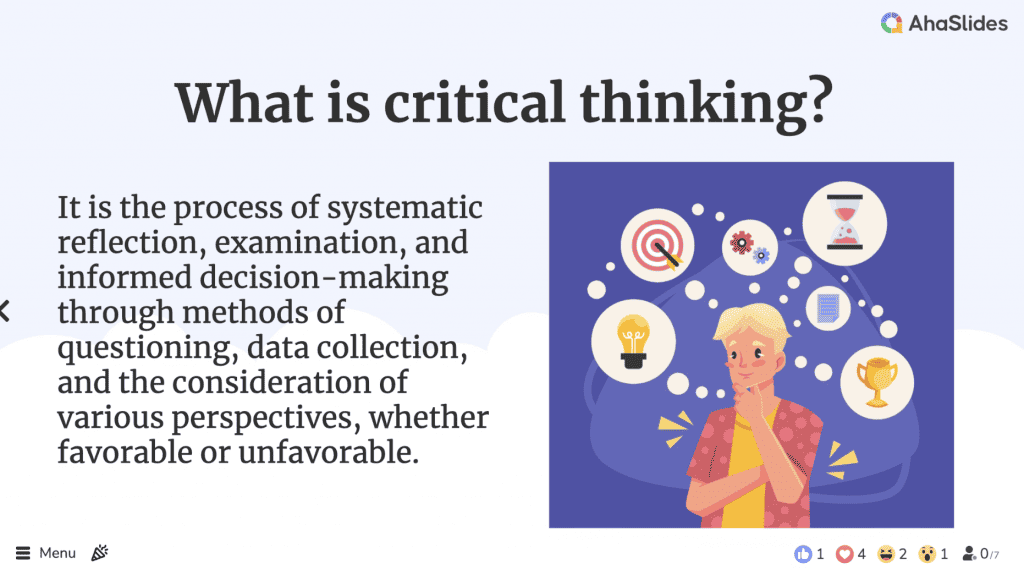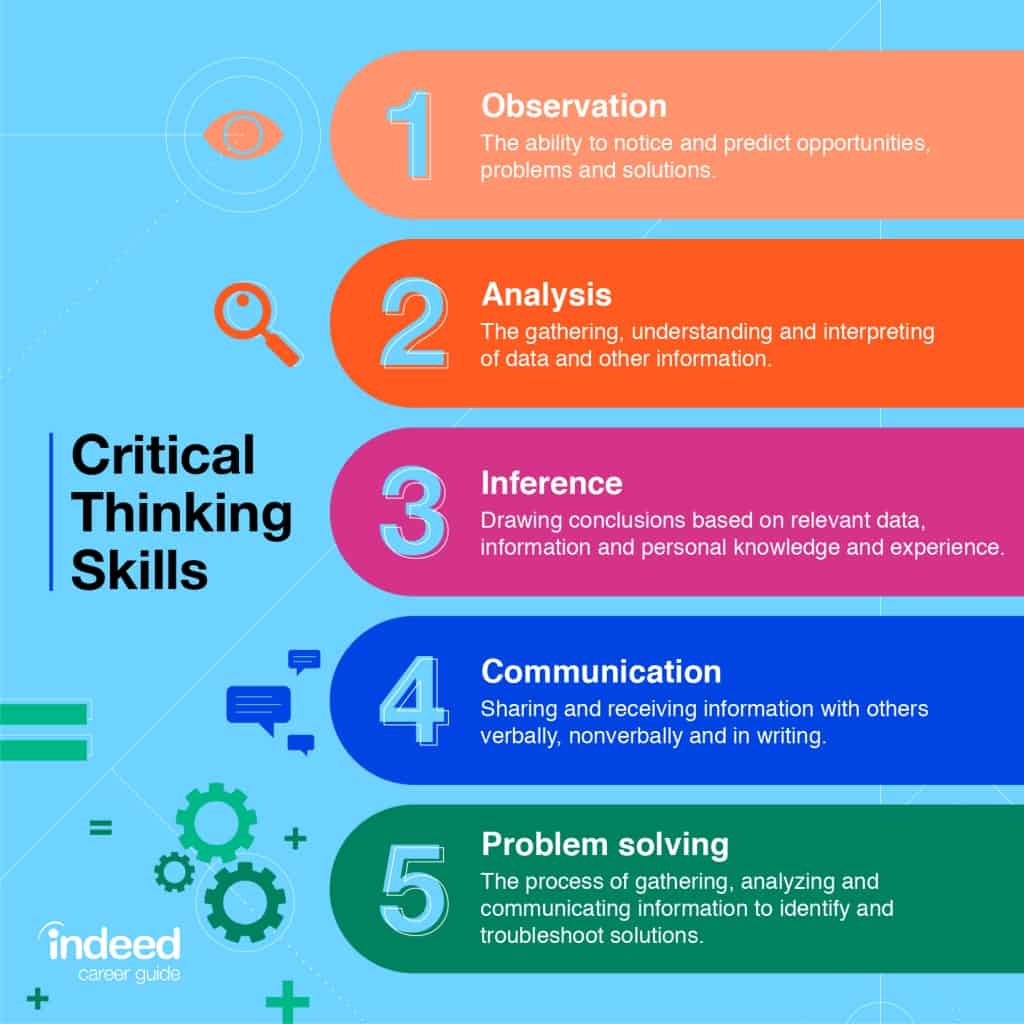What is critical thinking? Why do we need to think critically?
In a world overflowing with a wealth of information and a multitude of perspectives, the art of critical thinking shines as a guiding light, brightening ways to clarity and wisdom.
So, What is Critical Thinking, and How to improve it? Let's dive into this article to learn more insight! You will be surprised how critical thinking helps you live better, work better, and play better.

Table of Contents
- What is Critical Thinking?
- Why is Critical Thinking Important?
- How to Apply Critical Thinking and Examples?
- Key Takeaways
- Frequently Asked Questions
What is Critical Thinking?
What is Critical Thinking? It is process of systematic reflection, examination, and informed decision-making by way of questioning, data collection, and the consideration of diverse viewpoints, whether favorable or unfavorable. It aims to lead us to well-founded conclusions and judgments.
Critical thinking is not an inherent trait; it's not something we're born with. Individuals may exhibit varying levels of inherent curiosity and analytical prowess.
Instead, this skill and mindset evolve over time, nurtured by education, life experiences, and trustworthy practice. While not an innate quality, everyone possesses the potential to cultivate and sharpen this invaluable skill. It's a lifelong journey, demanding deliberate effort and an ongoing commitment to learning.

More Tips from AhaSlides

Looking for a tool to engage your team?
Gather your team members by a fun quiz on AhaSlides. Sign up to take free quiz from AhaSlides template library!
🚀 Grab Free Quiz☁️
Why is Critical Thinking Important?
What is critical thinking in your opinon? Is it important to think critically?
Critical thinking is essential because it empowers individuals to navigate the complex and information-rich world effectively. It enhances problem-solving abilities, helps in making informed decisions, and fosters a deeper understanding of issues. It is a valuable skill in education, career success, and everyday life, enabling individuals to think more clearly and critically in various contexts.
- Critical thinkers are highly appreciated in the professional world. Whether in leadership roles or as a team member, critical thinking plays a key role in delivering high job performance and workplace efficiency.
- In terms of education, critical thinking encourages students to go beyond rote memorization and actively engage with knowledge. It cultivates a hunger for learning and an intellectual curiosity that extends beyond the classroom.
- Critical thinking is not limited to academia or the workplace; it pervades everyday life. From evaluating news sources and making financial decisions to navigating personal relationships, critical thinking ensures individuals approach all aspects of life with clarity and discernment.
What is critical thinking skills? “Having advanced Critical Thinking skills leads to better interpersonal, business, and financial outcomes and is a protective factor against negative outcomes.” – Butler et al. (2012)

How to Apply Critical Thinking and Examples?
Effectively applying critical thinking involves a purposeful and methodical approach to analyzing information, reaching decisions, and addressing problems. Below are some practical steps to apply critical thinking adeptly:
- Define the Problem or Question: Begin by precisely outlining the problem or question that requires your attention. Be explicit about the matter you aim to resolve or comprehend.
- Gather Relevant Information: Accumulate relevant information, data, and supporting evidence pertaining to the issue or question. Rely on trustworthy sources and consider various perspectives.
- Question Assumptions: Identify any underlying assumptions or biases that may influence your thought process or the information at hand. Subject these assumptions to scrutiny to maintain objectivity.
- Analyze Information: Dissect the information into smaller components and thoroughly scrutinize each element. Seek out patterns, connections, and discrepancies.
- Consider Multiple Perspectives: Explore a variety of viewpoints and arguments related to the problem or question. Consider how others might approach the issue.
- Assessing the Evidence: Evaluate the trustworthiness, pertinence, and caliber of the evidence at your disposal. Confirm the reliability of your information sources and the precision of your data.
- Constructing Your Personal Perspective: Based on your analysis and evaluation, construct your viewpoint or hypothesis. Articulate your stance or conclusion clearly. Formulate your viewpoint or hypothesis based on your meticulous analysis and appraisal. Clearly articulate your standpoint or final judgment.
- Seek Feedback and Peer Review: Share your ideas with others and encourage constructive criticism and input. This process can contribute to honing your thinking and uncovering any hidden shortcomings.
- Consider Consequences: Contemplate the potential outcomes and repercussions of your decisions or conclusions. Consider how they might affect various stakeholders or scenarios.
- Make Informed Decisions: Utilize your critical thinking skills to make well-informed decisions or offer recommendations. Ensure that your choices are grounded in evidence and sound reasoning.
- Reflect and Learn: Subsequently, engage in introspection about the procedure and the outcomes. Evaluate what proved effective and pinpoint areas that could benefit from enhancement. Always bear in mind that critical thinking is an ever-evolving aptitude that can be honed through continuous practice.

It's important to note that critical thinking is adaptable and may vary depending on the context and the complexity of the issue. The crucial aspect is to approach it systematically, objectively, and with a willingness to embrace new information and perspectives as you employ critical thinking in your decision-making and problem-solving endeavors.
Scenario: Choosing a College Major
What is critical thinking in real life? This example shows you how important it is to think critically before making decisions.
Imagine you're a high school senior about to graduate, and you're faced with the decision of choosing a college major. This is a significant life choice that will shape your academic and career path. Here's how critical thinking can be applied in this situation:
| 1. Define the Problem: | The problem is selecting a college major that aligns with your interests, skills, and future career goals. |
| 2. Gather Relevant Information: | Research different majors, their course requirements, potential career opportunities, and the job market's demand for those majors. |
| 3. Question Assumptions: | Challenge assumptions like "I must choose a major that guarantees a high-paying job" or "I should choose what my parents want me to study." Consider your personal interests and passions. |
| 4. Analyze Information: | Examine the data you've gathered, such as the job outlook, average salaries, and the curriculum for each major. Look for patterns and connections. |
| 5. Consider Multiple Perspectives: | Talk to college advisors, professors, professionals in various fields, and peers who have chosen different majors. Get a diverse range of viewpoints. |
| 6. Evaluate the Evidence: | Assess the credibility and dependability of the details you've collected. Verify the precision of statistics and job market predictions. |
| 7. Formulate Your Own Viewpoint: | Based on your analysis, narrow down your options to a few majors that genuinely interest you and align with your long-term pursuits. |
| 8. Seek Feedback and Peer Review: | Discuss your alternatives with trusted friends, family members, or mentors who can provide insights and standpoints you might have missed. |
| 9. Consider Consequences: | Think about the potential outcomes of choosing each major. Consider not only the financial aspects but also your long-term happiness and fulfillment. |
| 10. Make an Informed Decision: | Ultimately, use critical thinking to make a well-informed decision about your college major, taking into account your interests, skills, career prospects, and personal values. |
| 11. Reflect and Learn: | After making your decision, reflect on the critical thinking process you applied. Keep an open mind to adjust your major if necessary as you gain more experience and insights during your college journey. |
In this example, critical thinking helps you make a thoughtful and informed decision about your college major, taking into consideration various factors and perspectives. This application of critical thinking can be a valuable skill throughout your educational and professional life.
Key Takeaways
🌟 Critical thinking goes with brainstorming. Let's learn more about brainstorming with AhaSlides, how to set up brainstorming sesson in class activities and business meetings!
Frequently Asked Questions
Why do we need critical thinking in life?
Critical thinking is essential for problem-solving, decision-making, effective communication, conflict resolution, continuous learning, avoiding biases, ethical choices, professional success, personal growth, and informed citizenship in a rapidly changing world. It empowers individuals to think rationally make informed choices, and contribute positively to their personal and societal well-being.
Can critical thinking be learned and improved?
Yes, critical thinking is a skill that can be learned and refined over time. There are various techniques and exercises, such as analyzing arguments, practicing logical reasoning, and seeking out diverse viewpoints, that can help individuals develop their critical thinking abilities. Continuous practice and self-reflection are key to improvement.
How can I encourage critical thinking in children and students?
Fostering critical thinking in young learners involves creating an environment that encourages curiosity, open-mindedness, and exploration. Encourage them to ask questions, analyze information, and consider multiple viewpoints. Engage in discussions, debates, and problem-solving activities. Encourage reading, exposure to diverse perspectives, and hands-on learning experiences to develop their critical thinking skills from an early age.
*Source: hbr








